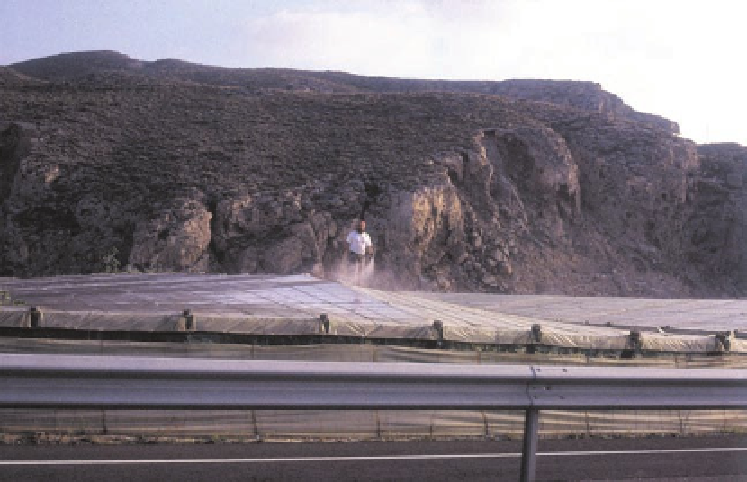Agriculture Reference
In-Depth Information
Photo 9.5.
Whitening of the greenhouse cover.
9.3.5
Control of the duration
of day/night
pepper), we wish to shade, in which case a
PAR decrease must be avoided using mobile
shading screens (Hanan, 1998).
The main problem of the screens is that
they are a nuisance when they are folded
and limit the light transmission. There are
several types of rails, folding (by hanging
wire or by rails) and rolling equipment.
They can be placed inside or above the
greenhouse, and must be mobile so they can
be deployed to move the screens when the
light levels are low.
If they are used only for shading, tex-
tiles with white or aluminium bands and
with holes for air exchange are commonly
used. Their light reduction usually ranges
from 20 to 80%. The light distribution may
be unequal, but it is better in the screens
without aluminium bands. If they are also
used for energy-saving purposes, lower
porosity screens must be used that still have
openings to allow the air to pass to avoid
high humidity levels.
The use of coloured screens alters the
quality of the light (Mortensen and Roe,
1992). The use of light diffusing additives in
the plastic films decreases direct light while
increasing diffuse light.
For more details on screens, see
Chapter 4.
In greenhouses the duration of the day can
be manipulated, altering the photoperiod,
to control the flowering of some ornamental
species, by means of their action on
phytochrome.
In relation to photoperiod, there are
two categories regarding the response of
plants to the alternation of day (light) and
night (dark): (i) short-day plants, which
flower or accelerate their flowering when
the duration of the day is shorter than its
critical photoperiod, normally less than
12 h; and (ii) long-day plants, in which
flower induction occurs only when the day
length is longer than its critical photope-
riod, usually more than 12.5 h. In some spe-
cies of long-day plants the certain threshold
in the 24 h cycle is related to the accumu-
lated radiation. Those plants whose flower-
ing is not dependent on the photoperiod
are the day-neutral plants. The response
mechanism to photoperiod is based on the
existence in the plants of a sort of 24 h
clock, marking the so-called circadian
rhythms (Hanan, 1998).
In assessing the duration of the day and
the night, the plant's biological clock may

